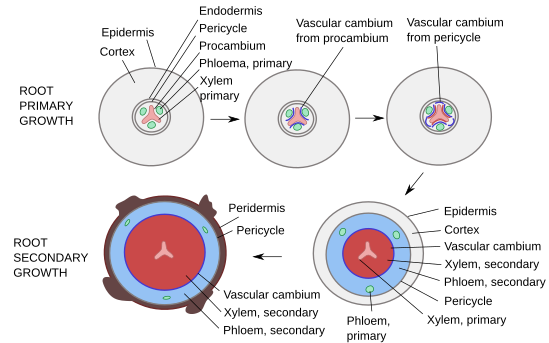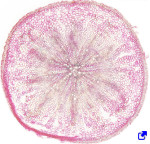Secondary growth leads to thicker roots and primary tissues like the epidermis, hypodermis, cortex, and endodermis are shed out. Secondary roots develop a suberized cortical layer that prevents the entry of water, although it can still enter through lenticels when they are present.
How the root secondary growth impact on the whole body plant is relevant for plant growth (and productivity in crops). Most monocot plants do not develop secondary roots, which may be caused by the loss of the procambium meristem from the vascular bundles. Auxyn, cytokinin, and giberelin, as well as strigolactones, promote secondary growth.
Only the main and largest lateral roots of dicot plants and gymnosperms show typical secondary growth. Secondary growth begins when the procambium meristem, found between the xylem and phloem, becomes the vascular cambium meristem. Depending on the number of phloem bundles, a variable number of segments of vascular cambium are formed (Figure 1). At the same time, portions of the pericycle close to the xylem spoke poles divide periclinally, giving inner cells that become vascular cambium meristem too. Later, the vascular cambium originated between xylem and phloem, and that originated from the pericycle, are connected to form a continuous structure: the root vascular cambium. It forms a cylinder parallel to the longitudinal axis of the root. Shortly after the continuous vascular cambium is formed, it produces secondary phloem toward the outer part and secondary xylem toward the inner part. The new layers of secondary xylem push the vascular cambium outwardly. In this way, the perimeter of the vascular cambium increases, the xylem progressively accumulates, and the root increases in thickness. Thus, the increase in diameter of the root is largely due to the accumulation of secondary xylem.

In this way, the secondary root gets organized similarly to the secondary stem. Indeed, there is continuity of the vascular tissues, as well as the vascular cambium, between the root and the stem. Unlike primary growth, there is no transition zone between the secondary stem and secondary root. The higher proportion of phloem compared to xylem and the less delimited growth rings in the roots make it possible to distinguish the root from the stem. In both the root and stem, the vascular cambium is composed of two types of cells: fusiform initial cells and radial initial cells. Fusiform initial cells differentiate into axially-oriented (vertical) cells, whereas radial initial cells give horizontally-oriented cells.

The periderm is the outer structure of the secondary root. Periderm is derived from the phellogen meristem (cork cambium) after the formation of secondary vascular tissue has begun. In the woody roots, the phellogen is formed from the pericycle and differentiates protective tissue outward, the so-called suber or bark. The epidermis and cortical parenchyma are shed. The secondary xylem, which is quite parenchymatous, becomes the main storage tissue of the root.
From the surface to the inner part, the following structures can be distinguished in a secondary root:
Epidermis-cortex/periderm. The secondary growth of the root may be more or less developed. At the beginning of secondary growth, roots show epidermis and cortex with parenchyma cells (cortical parenchyma). In more advanced secondary growth, the epidermis and cortex are replaced by the periderm, which is a protective layer derived from the cork cambium (phellogen), a lateral meristem differentiated from the pericycle.
Secondary phloem. It is differentiated from the vascular cambium meristem, and it is laid toward the outer part. The formation of the secondary phloem makes the primary phloem a residual tissue.
Vascular cambium. It is a lateral meristem responsible for the thickness increase of the root. It produces secondary phloem toward the outer part and secondary xylem toward the inner part. As the root gets thicker, the vascular cambium increases in size and moves away from the center of the root.
Secondary xylem. It is produced by the vascular cambium. It forms the wood of the root, and it is a dead tissue in the thicker roots. The most recent xylem is the most superficial. The vascular spokes are clearly visible in transversal sections of the xylem. The spokes are produced by the radial initial cells of the vascular cambium.
Primary xylem. It is generated during primary growth and is found in the inner part of the root. It is a death tissue in secondary roots.
The root growth is influenced by internal factors, such as the plant species, and by external factors, such as humidity, minerals, and other nutrients. In general, secondary growth provides higher water and mineral conductivity, stronger mechanical support, and makes root more resistant to pathogens and herbivores. On the other hand, the metabolic cost is higher for the plant. Therefore, plants have to choose between having thicker roots to improve water conduction and uptake more water and minerals from the soil and spending more energy to grow and maintain thicker roots. If the resources are scarce, it may not make a profit from making secondary roots. The activity of the vascular cambium determines the thickening rate of secondary roots.
Some species slow secondary growth to adapt to poor and low-water-content soils. In this situation, plants usually increase the length of their roots in order to explore more soil volume. However, some plants show secondary growth in dry soils because they are adapted to these environments. Another decision plants have to make is to be protected against pathogens or to get profit from mutualistic association with fungi and other beneficial microorganisms. For instance, the lack of phosphorous in the soil slows the secondary growth of the roots because it extends the period to form mycorrhizae and nodules. In the root segments with secondary growth, it is not possible to establish symbiotic associations.